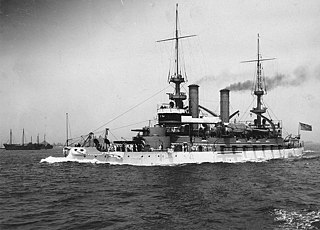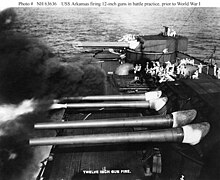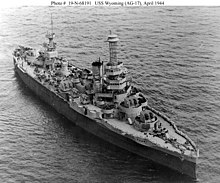
USS Delaware (BB-28) was a dreadnought battleship of the United States Navy, the lead ship of her class. She was laid down at Newport News Shipbuilding in November 1907, launched in January 1909, and completed in April 1910. The sixth ship to be named for the First State, Delaware was armed with a main battery of ten 12-inch (305 mm) guns all on the centerline, making her the most powerful battleship in the world at the time of her construction. She was also the first battleship of the US Navy to be capable of steaming at full speed for 24 continuous hours without suffering a breakdown.

USS Florida (BB-30) was the lead ship of the Florida class of dreadnought battleships of the United States Navy. She had one sister ship, Utah. Florida was laid down at the New York Navy Yard in March 1909, launched in May 1910, and commissioned into the US Navy in September 1911. She was armed with a main battery of ten 12-inch (305 mm) guns and was very similar in design to the preceding Delaware-class battleships.

USS Washington (BB-47), a Colorado-class battleship, was the second ship of the United States Navy named in honor of the 42nd state. Her keel was laid down on 30 June 1919, at Camden, New Jersey, by the New York Shipbuilding Corporation. She was launched on 1 September 1921, sponsored by Miss Jean Summers, the daughter of Congressman John W. Summers of Washington.

USS North Dakota (BB-29) was a dreadnought battleship of the United States Navy, the second member of the Delaware class, her only sister ship being Delaware. North Dakota was laid down at the Fore River Shipyard in December 1907, was launched in November 1908, and commissioned into the US Navy in April 1910. She was armed with a main battery of ten 12-inch (305 mm) guns and was capable of a top speed of 21 kn. North Dakota was the first vessel of the US Navy to be named after the 39th state.

The Tennessee class consisted of two super-dreadnought battleships—Tennessee and California—built for the United States Navy in the late 1910s, part of the "standard" series. The class was in most respects a repeat of the preceding New Mexico class, with the primary improvements being a significantly strengthened underwater protection system, and increased elevation of the main battery guns to allow them to fire at much greater ranges. They carried the same main battery of twelve 14-inch (356 mm) guns in four triple turrets, and had the same top speed of 21 knots. Both ships served in the Pacific Fleet for the duration of their careers, which included an extensive training program during the interwar period of the 1920s and 1930s.

USS Mississippi (BB-41/AG-128), the second of three members of the New Mexico class of battleship, was the third ship of the United States Navy named in honor of the 20th state. The ship was built at the Newport News Shipbuilding Company of Newport News, Virginia, from her keel laying in April 1915, her launching in January 1917, and her commissioning in December that year. She was armed with a battery of twelve 14-inch (356 mm) guns in four three-gun turrets, and was protected by heavy armor plate, with her main belt armor being 13.5 inches (343 mm) thick.

USS Idaho (BB-42), a New Mexico-class battleship, was the fourth ship of the United States Navy to be named for the 43rd state. She was the third of three ships of her class. Built by the New York Shipbuilding Corporation of Camden, New Jersey, she was launched in June 1917 and commissioned in March 1919. She was armed with a battery of twelve 14-inch (356 mm) guns in four three-gun turrets, and was protected by heavy armor plate, with her main belt armor being 13.5 inches (343 mm) thick.

USS Wyoming (BB-32) was the lead ship of her class of dreadnought battleships and was the third ship of the United States Navy named Wyoming, although she was only the second named in honor of the 44th state. Wyoming was laid down at the William Cramp & Sons in Philadelphia in February 1910, was launched in May 1911, and was completed in September 1912. She was armed with a main battery of twelve 12-inch (305 mm) guns and capable of a top speed of 20.5 kn.

The Indiana class was a class of three pre-dreadnought battleships launched in 1893. These were the first battleships built by the United States Navy comparable to contemporary European ships, such as the British HMS Hood. Authorized in 1890 and commissioned between November 1895 and April 1896, these were relatively small battleships with heavy armor and ordnance that pioneered the use of an intermediate battery. Specifically intended for coastal defense, their freeboard was insufficient to deal well with the waves of the open ocean. The turrets lacked counterweights, and the main belt armor was placed too low to be effective under most conditions.

The Nevada class comprised two dreadnought battleships—Nevada and Oklahoma—built for the United States Navy in the 1910s. They were significant developments in battleship design, being the first in the world to adopt "all or nothing" armor, a major step forward in armor protection because it emphasized protection optimized for long-range engagements before the Battle of Jutland demonstrated the need for such a layout. They also introduced three-gun turrets and oil-fired water-tube boilers to the US fleet. The two Nevadas were the progenitors of the standard-type battleship, a group that included the next four classes of broadly similar battleships that were intended to be tactically homogeneous.

The New Mexico class was a class of three super-dreadnought battleships built for the United States Navy in the late 1910s. The class comprised three ships: New Mexico, the lead ship, Mississippi, and Idaho. Part of the standard series, they were in most respects copies of the Pennsylvania-class battleships that immediately preceded them, carrying over the same main battery arrangement of twelve 14-inch (356 mm) guns, but now increased to 50-caliber. They incorporated several other improvements, including a better arrangement of the secondary battery that increased its usability, a clipper bow that improved seakeeping, and an experimental turbo-electric propulsion system adopted on New Mexico. Like the other standard-type battleships, they had a top speed of 21 knots that allowed the fleet to operate as a tactically homogeneous unit.

The Kearsarge-class was a group of two pre-dreadnought battleships built for the United States Navy in the 1890s. The two ships—USS Kearsarge and USS Kentucky—represented a compromise between two preceding battleship designs, the low-freeboard Indiana class and the high-freeboard USS Iowa, though their design also incorporated several improvements. Their primary advances over earlier designs consisted of new quick-firing guns and improved armor protection, but their most novel feature was their two-story gun turrets that consisted of a secondary 8-inch (203 mm) gun turret fixed to the top of their primary 13-inch (330 mm) turrets. The ships suffered from a number of problems, however, including a tertiary battery mounted too low in the hull and poorly-designed turrets, though the latter were attempted again with the Virginia class in the early 1900s, also with negative results.

The Illinois class was a group of three pre-dreadnought battleships of the United States Navy commissioned at the beginning of the 20th century. The three ships, Illinois, Alabama, and Wisconsin, were built between 1896 and 1901. They were transitional ships; they incorporated advances over preceding designs, including the first modern gun turrets for the main battery, and new rapid-firing secondary guns, but they were also the last American battleships to feature dated technologies like fire-tube boilers and Harvey armor. They were armed with a main battery of four 13-inch (330 mm) guns in two twin turrets, supported by a secondary battery of fourteen 6 in (150 mm) guns. The ships had a designed speed of 16 knots, though they exceeded that speed by a significant margin.

The three Maine-class battleships—Maine, Missouri, and Ohio—were built at the turn of the 20th century for the United States Navy. Based on the preceding Illinois class, they incorporated several significant technological advances over the earlier ships. They were the first American battleships to incorporate Krupp cemented armor, which was stronger than Harvey armor, smokeless powder, which allowed for higher-velocity guns and water-tube boilers, which were more efficient and lighter. The Maines were armed with four 12-inch (305 mm) guns and sixteen 6-inch (152 mm) guns, and they could steam at a speed of 18 knots, a significant increase over the Illinois class.

The Virginia class of pre-dreadnought battleships were built for the United States Navy in the early 1900s. The class comprised five ships: Virginia, Nebraska, Georgia, New Jersey, and Rhode Island. The ships carried a mixed-caliber offensive battery of four 12-inch (305 mm) and eight 8-inch (203 mm) guns; these were mounted in an uncommon arrangement, with four of the 8-inch guns placed atop the 12-inch turrets. The arrangement proved to be a failure, as the 8-inch guns could not be fired independently of the 12-inch guns without interfering with them. Additionally, by the time the Virginias entered service, the first "all-big-gun" battleships—including the British HMS Dreadnought—were nearing completion, which would render mixed battery ships like the Virginia class obsolete.

The Connecticut class of pre-dreadnought battleships were the penultimate class of the type built for the United States Navy. The class comprised six ships: Connecticut, Louisiana, Vermont, Kansas, Minnesota, and New Hampshire, which were built between 1903 and 1908. The ships were armed with a mixed offensive battery of 12-inch (305 mm), 8-inch (203 mm), and 7-inch (178 mm) guns. This arrangement was rendered obsolete by the advent of all-big-gun battleships like the British HMS Dreadnought, which was completed before most of the Connecticuts entered service.

The Mississippi class of battleships comprised two ships which were authorized in the 1903 naval budget: Mississippi and Idaho; these were named for the 20th and 43rd states, respectively. These were the last pre-dreadnought battleships to be designed for the United States Navy, but not the last to be built, because one more ship of a prior design was completed later under the 1904 naval budget. While the quality and technology of the weaponry and armor were first-rate, these ships included a variety of main, intermediate, secondary, and tertiary gun sizes in a predreadnought configuration which became obsolete before the ships were completed.

The Florida-class battleships of the United States Navy comprised two ships: Florida and Utah. Launched in 1910 and 1909 respectively and commissioned in 1911, they were slightly larger than the preceding Delaware class design but were otherwise very similar. This was the first US battleship class in which all ships received steam turbine engines. In the previous Delaware-class, North Dakota received steam turbine propulsion as an experiment while Delaware retained triple-expansion engines.

The Delaware-class battleships of the United States Navy were the second class of American dreadnoughts. With this class, the 16,000 long tons (16,257 t) limit imposed on capital ships by the United States Congress was waived, which allowed designers at the Navy's Bureau of Construction and Repair to correct what they considered flaws in the preceding South Carolina class and produce ships not only more powerful but also more effective and rounded overall. Launched in 1909, these ships became the first in US naval history to exceed 20,000 long tons (20,321 t).

The New York class was a pair of super-dreadnought battleships built for the United States Navy between 1911 and 1914. The two ships of the class, New York and Texas, saw extensive service beginning in the occupation of Veracruz, World War I, and World War II.






















